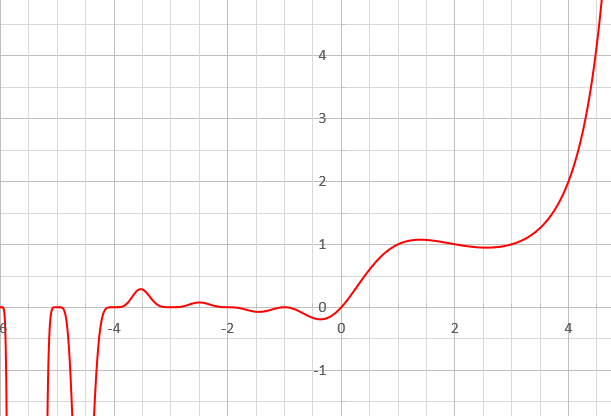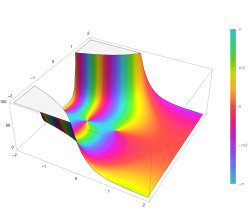Barnes G-function
In mathematics, the Barnes G-function G(z) is a function that is an extension of superfactorials to the complex numbers. It is related to the gamma function, the K-function and the Glaisher–Kinkelin constant, and was named after mathematician Ernest William Barnes.[1] It can be written in terms of the double gamma function.
Formally, the Barnes G-function is defined in the following Weierstrass product form:
- [math]\displaystyle{ G(1+z)=(2\pi)^{z/2} \exp\left(- \frac{z+z^2(1+\gamma)}{2} \right) \, \prod_{k=1}^\infty \left\{ \left(1+\frac{z}{k}\right)^k \exp\left(\frac{z^2}{2k}-z\right) \right\} }[/math]
where [math]\displaystyle{ \, \gamma }[/math] is the Euler–Mascheroni constant, exp(x) = ex is the exponential function, and Π denotes multiplication (capital pi notation).
The integral representation, which may be deduced from the relation to the double gamma function, is
- [math]\displaystyle{ \log G(1+z) = \frac{z}{2}\log(2\pi) +\int_0^\infty\frac{dt}{t}\left[\frac{1-e^{-zt}}{4\sinh^2\frac{t}{2}} +\frac{z^2}{2}e^{-t} -\frac{z}{t}\right] }[/math]
As an entire function, G is of order two, and of infinite type. This can be deduced from the asymptotic expansion given below.
Functional equation and integer arguments
The Barnes G-function satisfies the functional equation
- [math]\displaystyle{ G(z+1)=\Gamma(z)\, G(z) }[/math]
with normalisation G(1) = 1. Note the similarity between the functional equation of the Barnes G-function and that of the Euler gamma function:
- [math]\displaystyle{ \Gamma(z+1)=z \, \Gamma(z) . }[/math]
The functional equation implies that G takes the following values at integer arguments:
- [math]\displaystyle{ G(n)=\begin{cases} 0&\text{if }n=0,-1,-2,\dots\\ \prod_{i=0}^{n-2} i!&\text{if }n=1,2,\dots\end{cases} }[/math]
(in particular, [math]\displaystyle{ \,G(0)=0, G(1)=1 }[/math]) and thus
- [math]\displaystyle{ G(n)=\frac{(\Gamma(n))^{n-1}}{K(n)} }[/math]
where [math]\displaystyle{ \,\Gamma(x) }[/math] denotes the gamma function and K denotes the K-function. The functional equation uniquely defines the Barnes G-function if the convexity condition,
- [math]\displaystyle{ (\forall x \geq 1) \, \frac{\mathrm{d}^3}{\mathrm{d}x^3}\log(G(x))\geq 0 }[/math]
is added.[2] Additionally, the Barnes G-function satisfies the duplication formula,[3]
- [math]\displaystyle{ G(x)G\left(x+\frac{1}{2}\right)^{2}G(x+1)=e^{\frac{1}{4}}A^{-3}2^{-2x^{2}+3x-\frac{11}{12}}\pi^{x-\frac{1}{2}}G\left(2x\right) }[/math]
Characterisation
Similar to the Bohr-Mollerup theorem for the gamma function, for a constant [math]\displaystyle{ c\gt 0 }[/math], we have for [math]\displaystyle{ f(x)=cG(x) }[/math][4]
[math]\displaystyle{ f(x+1)=\Gamma(x)f(x) }[/math]
and for [math]\displaystyle{ x\gt 0 }[/math]
[math]\displaystyle{ f(x+n)\sim \Gamma(x)^nn^{{x\choose 2}}f(n) }[/math]
as [math]\displaystyle{ n\to\infty }[/math].
Value at 1/2
- [math]\displaystyle{ \begin{align}G\left(\tfrac{1}{2}\right) &= 2^{\frac{1}{24}} \, e^{\frac32 \zeta'(-1)} \, \pi^{-\frac14}\\ &= 2^{\frac{1}{24}} \, e^{\frac{1}{8}} \, \pi^{-\frac{1}{4}} \, A^{-\frac{3}{2}},\end{align} }[/math]
where [math]\displaystyle{ A }[/math] is the Glaisher–Kinkelin constant.[citation needed][importance?]
Reflection formula 1.0
The difference equation for the G-function, in conjunction with the functional equation for the gamma function, can be used to obtain the following reflection formula for the Barnes G-function (originally proved by Hermann Kinkelin):
- [math]\displaystyle{ \log G(1-z) = \log G(1+z)-z\log 2\pi+ \int_0^z \pi x \cot \pi x \, dx. }[/math]
The logtangent integral on the right-hand side can be evaluated in terms of the Clausen function (of order 2), as is shown below:
- [math]\displaystyle{ 2\pi \log\left( \frac{G(1-z)}{G(1+z)} \right)= 2\pi z\log\left(\frac{\sin\pi z}{\pi} \right) + \operatorname{Cl}_2(2\pi z) }[/math]
The proof of this result hinges on the following evaluation of the cotangent integral: introducing the notation [math]\displaystyle{ \operatorname{Lc}(z) }[/math] for the logcotangent integral, and using the fact that [math]\displaystyle{ \,(d/dx) \log(\sin\pi x)=\pi\cot\pi x }[/math], an integration by parts gives
- [math]\displaystyle{ \begin{align} \operatorname{Lc}(z) &= \int_0^z\pi x\cot \pi x\,dx \\ &= z\log(\sin \pi z)-\int_0^z\log(\sin \pi x)\,dx \\ &= z\log(\sin \pi z)-\int_0^z\Bigg[\log(2\sin \pi x)-\log 2\Bigg]\,dx \\ &= z\log(2\sin \pi z)-\int_0^z\log(2\sin \pi x)\,dx . \end{align} }[/math]
Performing the integral substitution [math]\displaystyle{ \, y=2\pi x \Rightarrow dx=dy/(2\pi) }[/math] gives
- [math]\displaystyle{ z\log(2\sin \pi z)-\frac{1}{2\pi}\int_0^{2\pi z}\log\left(2\sin \frac{y}{2} \right)\,dy. }[/math]
The Clausen function – of second order – has the integral representation
- [math]\displaystyle{ \operatorname{Cl}_2(\theta) = -\int_0^{\theta}\log\Bigg|2\sin \frac{x}{2} \Bigg|\,dx. }[/math]
However, within the interval [math]\displaystyle{ \, 0 \lt \theta \lt 2\pi }[/math], the absolute value sign within the integrand can be omitted, since within the range the 'half-sine' function in the integral is strictly positive, and strictly non-zero. Comparing this definition with the result above for the logtangent integral, the following relation clearly holds:
- [math]\displaystyle{ \operatorname{Lc}(z)=z\log(2\sin \pi z)+\frac{1}{2\pi} \operatorname{Cl}_2(2\pi z). }[/math]
Thus, after a slight rearrangement of terms, the proof is complete:
- [math]\displaystyle{ 2\pi \log\left( \frac{G(1-z)}{G(1+z)} \right)= 2\pi z\log\left(\frac{\sin\pi z}{\pi} \right)+\operatorname{Cl}_2(2\pi z)\, . \, \Box }[/math]
Using the relation [math]\displaystyle{ \, G(1+z)=\Gamma(z)\, G(z) }[/math] and dividing the reflection formula by a factor of [math]\displaystyle{ \, 2\pi }[/math] gives the equivalent form:
- [math]\displaystyle{ \log\left( \frac{G(1-z)}{G(z)} \right)= z\log\left(\frac{\sin\pi z}{\pi} \right)+\log\Gamma(z)+\frac{1}{2\pi}\operatorname{Cl}_2(2\pi z) }[/math]
Ref: see Adamchik below for an equivalent form of the reflection formula, but with a different proof.
Reflection formula 2.0
Replacing z with (1/2) − z'' in the previous reflection formula gives, after some simplification, the equivalent formula shown below (involving Bernoulli polynomials):
- [math]\displaystyle{ \log\left( \frac{ G\left(\frac{1}{2}+z\right) }{ G\left(\frac{1}{2}-z\right) } \right) = \log \Gamma \left(\frac{1}{2}-z \right) + B_1(z) \log 2\pi+\frac{1}{2}\log 2+\pi \int_0^z B_1(x) \tan \pi x \,dx }[/math]
Taylor series expansion
By Taylor's theorem, and considering the logarithmic derivatives of the Barnes function, the following series expansion can be obtained:
- [math]\displaystyle{ \log G(1+z) = \frac{z}{2}\log 2\pi -\left( \frac{z+(1+\gamma)z^2}{2} \right) + \sum_{k=2}^{\infty}(-1)^k\frac{\zeta(k)}{k+1}z^{k+1}. }[/math]
It is valid for [math]\displaystyle{ \, 0 \lt z \lt 1 }[/math]. Here, [math]\displaystyle{ \, \zeta(x) }[/math] is the Riemann Zeta function:
- [math]\displaystyle{ \zeta(s)=\sum_{n=1}^{\infty}\frac{1}{n^s}. }[/math]
Exponentiating both sides of the Taylor expansion gives:
- [math]\displaystyle{ \begin{align} G(1+z) &= \exp \left[ \frac{z}{2}\log 2\pi -\left( \frac{z+(1+\gamma)z^2}{2} \right) + \sum_{k=2}^{\infty}(-1)^k\frac{\zeta(k)}{k+1}z^{k+1} \right] \\ &=(2\pi)^{z/2}\exp\left[ -\frac{z+(1+\gamma)z^2}{2} \right] \exp \left[\sum_{k=2}^{\infty}(-1)^k\frac{\zeta(k)}{k+1}z^{k+1} \right].\end{align} }[/math]
Comparing this with the Weierstrass product form of the Barnes function gives the following relation:
- [math]\displaystyle{ \exp \left[\sum_{k=2}^\infty (-1)^k\frac{\zeta(k)}{k+1}z^{k+1} \right] = \prod_{k=1}^{\infty} \left\{ \left(1+\frac{z}{k}\right)^k \exp \left(\frac{z^2}{2k}-z\right) \right\} }[/math]
Multiplication formula
Like the gamma function, the G-function also has a multiplication formula:[5]
- [math]\displaystyle{ G(nz)= K(n) n^{n^{2}z^{2}/2-nz} (2\pi)^{-\frac{n^2-n}{2}z}\prod_{i=0}^{n-1}\prod_{j=0}^{n-1}G\left(z+\frac{i+j}{n}\right) }[/math]
where [math]\displaystyle{ K(n) }[/math] is a constant given by:
- [math]\displaystyle{ K(n)= e^{-(n^2-1)\zeta^\prime(-1)} \cdot n^{\frac{5}{12}}\cdot(2\pi)^{(n-1)/2}\,=\, (Ae^{-\frac{1}{12}})^{n^2-1}\cdot n^{\frac{5}{12}}\cdot (2\pi)^{(n-1)/2}. }[/math]
Here [math]\displaystyle{ \zeta^\prime }[/math] is the derivative of the Riemann zeta function and [math]\displaystyle{ A }[/math] is the Glaisher–Kinkelin constant.
Absolute value
It holds true that [math]\displaystyle{ G(\overline z)=\overline{G(z)} }[/math], thus [math]\displaystyle{ |G(z)|^2=G(z)G(\overline z) }[/math]. From this relation and by the above presented Weierstrass product form one can show that
- [math]\displaystyle{ |G(x+iy)|=|G(x)|\exp\left(y^2\frac{1+\gamma}{2}\right)\sqrt{1+\frac{y^2}{x^2}}\sqrt{\prod_{k=1}^\infty\left(1+\frac{y^2}{(x+k)^2}\right)^{k+1}\exp\left(-\frac{y^2}{k}\right)}. }[/math]
This relation is valid for arbitrary [math]\displaystyle{ x\in\mathbb{R}\setminus\{0,-1,-2,\dots\} }[/math], and [math]\displaystyle{ y\in\mathbb{R} }[/math]. If [math]\displaystyle{ x=0 }[/math], then the below formula is valid instead:
- [math]\displaystyle{ |G(iy)|=y\exp\left(y^2\frac{1+\gamma}{2}\right)\sqrt{\prod_{k=1}^\infty\left(1+\frac{y^2}{k^2}\right)^{k+1}\exp\left(-\frac{y^2}{k}\right)} }[/math]
for arbitrary real y.
Asymptotic expansion
The logarithm of G(z + 1) has the following asymptotic expansion, as established by Barnes:
- [math]\displaystyle{ \begin{align} \log G(z+1) = {} & \frac{z^2}{2} \log z - \frac{3z^2}{4} + \frac{z}{2}\log 2\pi -\frac{1}{12} \log z \\ & {} + \left(\frac{1}{12}-\log A \right) +\sum_{k=1}^N \frac{B_{2k + 2}}{4k\left(k + 1\right)z^{2k}}~+~O\left(\frac{1}{z^{2N + 2}}\right). \end{align} }[/math]
Here the [math]\displaystyle{ B_k }[/math] are the Bernoulli numbers and [math]\displaystyle{ A }[/math] is the Glaisher–Kinkelin constant. (Note that somewhat confusingly at the time of Barnes [6] the Bernoulli number [math]\displaystyle{ B_{2k} }[/math] would have been written as [math]\displaystyle{ (-1)^{k+1} B_k }[/math], but this convention is no longer current.) This expansion is valid for [math]\displaystyle{ z }[/math] in any sector not containing the negative real axis with [math]\displaystyle{ |z| }[/math] large.
Relation to the Loggamma integral
The parametric Loggamma can be evaluated in terms of the Barnes G-function (Ref: this result is found in Adamchik below, but stated without proof):
- [math]\displaystyle{ \int_0^z \log \Gamma(x)\,dx=\frac{z(1-z)}{2}+\frac{z}{2}\log 2\pi +z\log\Gamma(z) -\log G(1+z) }[/math]
The proof is somewhat indirect, and involves first considering the logarithmic difference of the gamma function and Barnes G-function:
- [math]\displaystyle{ z\log \Gamma(z)-\log G(1+z) }[/math]
where
- [math]\displaystyle{ \frac{1}{\Gamma(z)}= z e^{\gamma z} \prod_{k=1}^\infty \left\{ \left(1+\frac{z}{k}\right)e^{-z/k} \right\} }[/math]
and [math]\displaystyle{ \,\gamma }[/math] is the Euler–Mascheroni constant.
Taking the logarithm of the Weierstrass product forms of the Barnes G-function and gamma function gives:
- [math]\displaystyle{ \begin{align} & z\log \Gamma(z)-\log G(1+z)=-z \log\left(\frac{1}{\Gamma (z)}\right)-\log G(1+z) \\[5pt] = {} & {-z} \left[ \log z+\gamma z +\sum_{k=1}^\infty \Bigg\{ \log\left(1+\frac{z}{k} \right) -\frac{z}{k} \Bigg\} \right] \\[5pt] & {} -\left[ \frac{z}{2}\log 2\pi -\frac{z}{2}-\frac{z^2}{2} -\frac{z^2 \gamma}{2} + \sum_{k=1}^\infty \Bigg\{k\log\left(1+\frac{z}{k}\right) +\frac{z^2}{2k} -z \Bigg\} \right] \end{align} }[/math]
A little simplification and re-ordering of terms gives the series expansion:
- [math]\displaystyle{ \begin{align} & \sum_{k=1}^\infty \Bigg\{ (k+z)\log \left(1+\frac{z}{k}\right)-\frac{z^2}{2k}-z \Bigg\} \\[5pt] = {} & {-z}\log z-\frac{z}{2}\log 2\pi +\frac{z}{2} +\frac{z^2}{2}- \frac{z^2 \gamma}{2}- z\log\Gamma(z) +\log G(1+z) \end{align} }[/math]
Finally, take the logarithm of the Weierstrass product form of the gamma function, and integrate over the interval [math]\displaystyle{ \, [0,\,z] }[/math] to obtain:
- [math]\displaystyle{ \begin{align} & \int_0^z\log\Gamma(x)\,dx=-\int_0^z \log\left(\frac{1}{\Gamma(x)}\right)\,dx \\[5pt] = {} & {-(z\log z-z)}-\frac{z^2 \gamma}{2}- \sum_{k=1}^\infty \Bigg\{ (k+z)\log \left(1+\frac{z}{k}\right)-\frac{z^2}{2k}-z \Bigg\} \end{align} }[/math]
Equating the two evaluations completes the proof:
- [math]\displaystyle{ \int_0^z \log \Gamma(x)\,dx=\frac{z(1-z)}{2}+\frac{z}{2}\log 2\pi +z\log\Gamma(z) -\log G(1+z) }[/math]
And since [math]\displaystyle{ \, G(1+z)=\Gamma(z)\, G(z) }[/math] then,
- [math]\displaystyle{ \int_0^z \log \Gamma(x)\,dx=\frac{z(1-z)}{2}+\frac{z}{2}\log 2\pi -(1-z)\log\Gamma(z) -\log G(z)\, . }[/math]
References
- ↑ E. W. Barnes, "The theory of the G-function", Quarterly Journ. Pure and Appl. Math. 31 (1900), 264–314.
- ↑ M. F. Vignéras, L'équation fonctionelle de la fonction zêta de Selberg du groupe mudulaire SL[math]\displaystyle{ (2,\mathbb{Z}) }[/math], Astérisque 61, 235–249 (1979).
- ↑ Park, Junesang (1996). "A duplication formula for the double gamma function $Gamma_2$". Bulletin of the Korean Mathematical Society 33 (2): 289–294. https://koreascience.kr/article/JAKO199611919482150.page.
- ↑ Marichal, Jean Luc. A Generalization of Bohr-Mollerup’s Theorem for Higher Order Convex Functions. Springer. pp. 218. https://orbi.uliege.be/bitstream/2268/294009/1/Marichal-Zena%C3%AFdi2022_Book_AGeneralizationOfBohr-Mollerup.pdf.
- ↑ I. Vardi, Determinants of Laplacians and multiple gamma functions, SIAM J. Math. Anal. 19, 493–507 (1988).
- ↑ E. T. Whittaker and G. N. Watson, "A Course of Modern Analysis", CUP.
- Askey, R.A.; Roy, R. (2010), "Barnes G-function", in Olver, Frank W. J.; Lozier, Daniel M.; Boisvert, Ronald F. et al., NIST Handbook of Mathematical Functions, Cambridge University Press, ISBN 978-0-521-19225-5, http://dlmf.nist.gov/5.17
- Adamchik, Viktor S. (2003). "Contributions to the Theory of the Barnes function". arXiv:math/0308086.
 |


